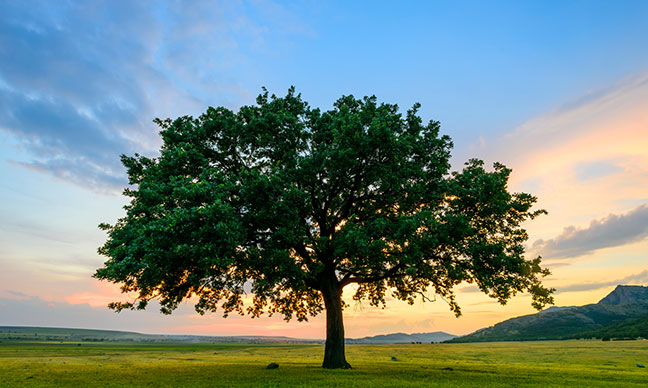Fitting in the USDA hardiness zones 9b and 10a, Santa Clarita features hot, clear, and arid summers with the winters being wet, cold, and partly cloudy. The best Santa Clarita trees are supposed to withstand these climatic conditions while doing well in the clay soils common in this part of California.
To keep property owners from going wrong with their tree selection, Santa Clarita tree service experts recommend going native. Perfectly suited for all corners of the Santa Clarita region, the following native trees should do well with minimal care.
Top-Rated Santa Clarita Trees
1. Oak
Dating back to the 1800s, oak trees are a significant part of Santa Clarita’s pastoral beauty. In recognition of their contribution to the natural environment, residents – through the local government – enacted the Santa Clarita tree ordinance to protect these trees against damage or removal.
Related Posts: Oak Tree Care & California Shade Trees
Considered one of the best shade trees, oaks grow to a height of between 50 and 70 feet. Adapting well to a wide variety of soil conditions, oak trees are generally free from diseases and pests. Featuring a long life-span – on average, they live to over 200 years – oak trees serve as good history representatives.
Related Posts: California Oakworm & Oak Tree Diseases California
2. Australian Willow
One of the best evergreen trees in California, the Australia Willow features a moderate growth rate, growing to reach a height of 30 feet and canopy width of up to 20 feet. Featuring narrow leaves that hang down in a weeping form, the tree rarely needs pruning.
Ideal for people looking to have some color on their landscapes, the tree grows small fragrant flowers in the spring season. While the Santa Clarita tree ordinance does not protect the Australian Willow, the tree does well for its ability to fit almost anywhere, tolerating almost all growing conditions.
3. Chitalpa
A medium-sized tree, Chitalpa grows fast to reach a height of between 20 and 30 feet with a crown spread of about 25 feet. Thriving in desert conditions, the tree hates being overwatered, making it ideal for parts of Santa Clarita that feature long dry stretches.
Flowering during the warm months, Chitalpa produces either white or pink flowers, depending on the variety. Though the tree is deciduous – meaning that it drops its flowers in the fall – it carries a branching structure that makes it interesting even when bare.
4. Chinese Pistache
Perfectly suited for lawns, patios, and parkways, the Chinese Pistache is one of the few Santa Clarita trees that provide excellent color in fall – red and orange flowers – just before shedding its leaves. The moderate grower reaches maturity with a height of between 25 and 40 feet.
A bit awkward in appearance when young, the tree eventually becomes symmetrical, forming an upright oval shape. Older trees carry an interesting, deeply fissured trunk bark and lustrous, finely-divided dark green leaves.
5. Crape Myrtle
One of the most versatile Santa Clarita trees, Crape Myrtle is deciduous, with its smooth peeling bark being part of its charm. Blooming in the summer months, the tree carries its color through to the fall season.
Very drought resistant and preferring areas with a lot of heat, the tree works well in areas that may have water shortages. Carrying a non-invasive root system, the tree is perfect near walkways and in narrow spaces.
6. Palo Verde
The name Palo Verde – Spanish for green stick or wood – alludes to the tree’s greenish trunk and branches. Available in two main species – the Foothill Palo Verde and Blue Palo Verdes – the tree grows to a height of between 20 and 40 feet, with Blue Palo Verde being the bigger tree.
The tree’s young branches and leaves are bluish-green, with the foothill species carrying more abundant leaves that grow on its long branches. During the flowering season, both species carry thousands of five-petaled yellow blossoms. Drought-resistant, Palo Verdes drop their leaves in dry seasons, regaining them the moment there is enough water.
FAQs
Q: What Planting Zone is Santa Clarita?
A: Santa Clarita is in the USDA hardiness zones 9b and 10a. The region features hot summers and mild winters, with the annual extreme low-temperature range falling between 25- and 30-degree Fahrenheit.
Q: When Can I Plant in Zone 9b?
A: Typically, the growing season in zone 9b starts in late February, generally lasting to early December. If the days are mostly sunny, property owners in Santa Clarita can extend the planting season to the end of the year.
Local Tree Experts Overview
While they are not celebrated as much as they should, few things are as iconic as trees that are native to a specific region. Since they are suited to the region’s climate and soil conditions, the trees last for a long time. They stand witness to history, becoming rooted in place, sometimes for hundreds of years, as generations of people come and go.
In this guide, we have outlined the best Santa Clarita trees, including those that are protected by the Santa Clarita tree ordinance. Very resilient and resistant to diseases, you should be able to keep the trees above healthy with minimal arborist intervention.




